Seagate's Momentus XT Reviewed, Finally a Good Hybrid HDD
by Anand Lal Shimpi on May 24, 2010 9:31 AM EST- Posted in
- Storage
- SSDs
- Seagate
- Momentus XT
- Hybrid Drive
- SSHDs
The Test - Real World First
Before we get to our usual benchmarks I put together a few hand timed tests to help convey the experience the Momentus XT offers. Seagate badly wants the world to think that the Momentus XT is SSD-like in its performance. In my opinion it performs more like a fast hard drive rather than an SSD, but regardless of what you want to call it the tests below are designed to help convey the user experience.
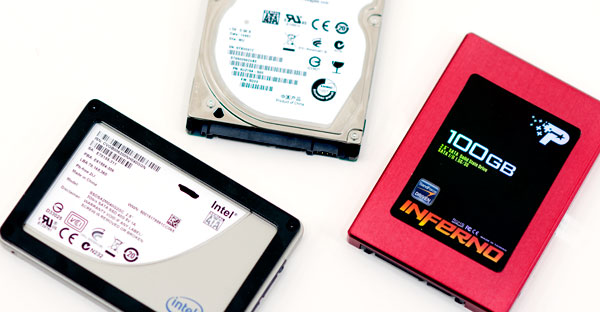
To aid in our comparison I've thrown in two SSDs: the Intel X25-V and the Patriot Inferno. The X25-V is a small, but affordable SSD while the Inferno is based on the SandForce SF-1200 controller making it one of the fastest and most expensive consumer SSDs we've tested. We've also got the new 600GB VelociRaptor and Seagate's own Momentus 5400.6, a fairly standard 5400RPM 2.5" drive for comparison. While a better comparison would have been a modern 7200RPM 2.5" drive, we didn't have one handy in time for this review. The 5400.6 should give you a general idea of how all 2.5" drives will perform though; 7200RPM drives will be faster but not by a huge margin.
These are mature results, measured on the third of three runs so the Momentus XT has more than enough time to learn (between each run I rebooted the machine).
| CPU | Intel Core i7 965 running at 3.2GHz (Turbo & EIST Disabled) |
| Motherboard: | Intel DX58SO (Intel X58) |
| Chipset: | Intel X58 + Marvell SATA 6Gbps PCIe |
| Chipset Drivers: | Intel 9.1.1.1015 + Intel IMSM 8.9 |
| Memory: | Qimonda DDR3-1333 4 x 1GB (7-7-7-20) |
| Video Card: | eVGA GeForce GTX 285 |
| Video Drivers: | NVIDIA ForceWare 190.38 64-bit |
| Desktop Resolution: | 1920 x 1200 |
| OS: | Windows 7 x64 |
Our first test is a timed boot. You are looking at the time from initial OS load (not POST) to getting a cursor at the Windows 7 desktop.
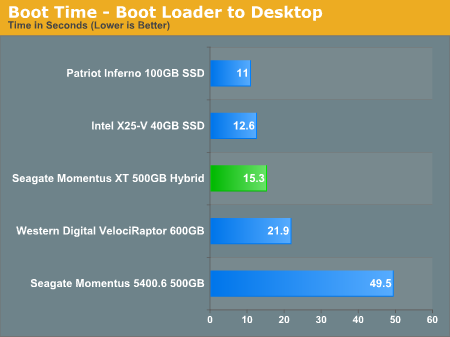
The Windows 7 boot process is a very read intensive task that's easy for the Momentus XT to learn. Seagate may be on to something here, the Momentus XT is much more like a SSD than a HDD in this test. Even the VelociRaptor is no match for it. The SSDs are still faster, but they don't offer nearly the same capacity as the hybrid drive. Compared to a standard 2.5" notebook drive the Momentus XT is a no brainer, it's in a league of its own.
Adobe's Photoshop CS4 is a great application launch test as it can take a fairly long time to load. Here we're just timing the period from clicking on the CS4 icon to ending up at the Photoshop workspace.
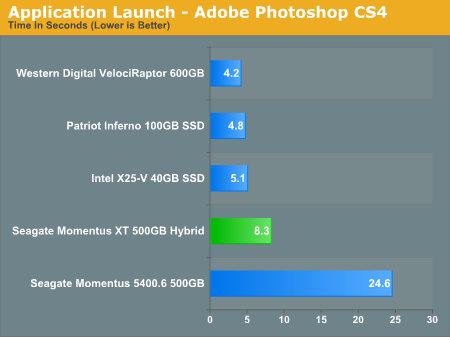
The new VelociRaptor is slightly, but consistently faster than both of the SSDs in this chart. It does still have a few tricks left up its sleeve. The Momentus XT is about half the speed of the SSDs and 10K RPM HDD here, but much faster than the 2.5" 5400RPM notebook hard drive. It's noticeably faster than your standard notebook HDD but it does feel slower than a SSD. That is an important distinction as throughout my experience with the drive it felt like a fast hard drive, rather than an SSD. Part of the reason there is because the NAND isn't used for writes, so you still get the high latency response time whenever there are any random writes happening in the background.
Our standard Photoshop CS4 performance test in our reviews is optimized for comparing CPUs and as such it's set to only record the previous action. With only one level of history, the benchmark is not nearly as disk intensive as Photoshop can get. For this test I ran our CS4 benchmark but left the application at its default setting of remembering the previous 20 actions. With more to keep track of, performance goes down while the reliance on a fast storage subsystem goes up.
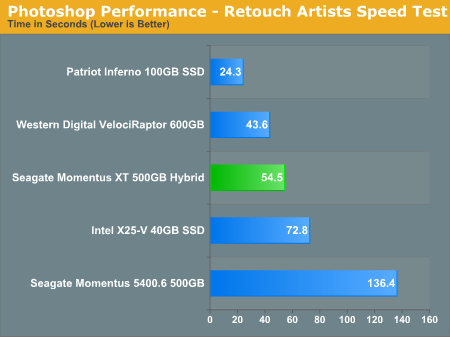
The X25-V is penalized by having a very low sequential write speed. The combination of heavy reads and writes means that the Momentus XT behaves more like a normal hard drive and less like an SSD. The 4GB SLC read cache does help though, while the hybrid drive isn't faster than the VelociRaptor it's pretty close for being a 2.5" notebook drive. The 100GB SandForce drive is much faster than anything else here, but it does offer 1/5 the space at 2.5x the cost of the Momentus XT.
For the next test I wanted to see how well the Momentus XT would cache a single large file. I timed how long it took to load a 70MB Excel sheet:
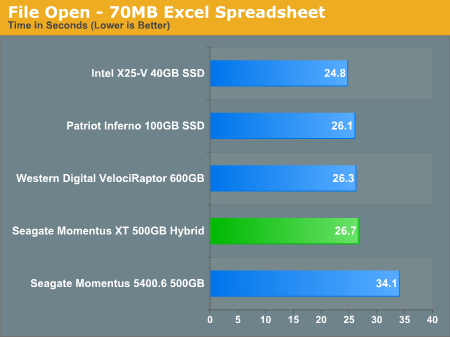
The results are a lot closer than you'd expect. Despite having a 4GB SLC NAND read cache, the Excel load time isn't any better than the VelociRaptor (although it is faster than the 2.5" 5400RPM drive). The upper bound in performance is set by the SSDs so it looks like the Momentus XT's cache does as much as physically possible to improve performance, we're simply bound elsewhere.
My favorite test for showing the usefulness of an SSD is to load a bunch of applications immediately after booting to the desktop. On a system with a hard drive there are usually a lot of disk accesses right after you hit the desktop that will slow down any application launches. A well made SSD acts like nothing is going on in the background. But what about the Momentus XT?
To test it I threw Internet Explorer, Outlook 2007, Access 2007, Excel 2007, PowerPoint 2007, Word 2007 and Photoshop CS4 in the startup folder of my testbed. The times below measure how long it took to load all of those applications immediately after boot:
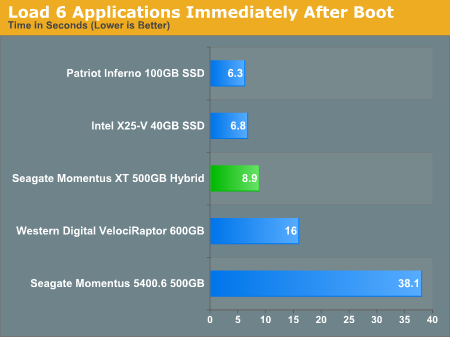
I'm impressed. While it's not quite as fast as an SSD, Seagate's Momentus XT is faster than any hard drive here. It's fast enough in this test where you might even consider using one in a desktop instead of a VelociRaptor. There is still the issue of random write performance (it is a 7200RPM 2.5" drive after all) but this is very good. It's because of this that Seagate believes the Momentus XT is delivering a SSD-like experience and in this test I'd have to agree.










120 Comments
View All Comments
7Enigma - Tuesday, May 25, 2010 - link
" With So much RAM we could cache those Random Read Write Directly to RAM. Why would we need a Hybrid HDD?"I think what is confusing you is the differences between RAM and Flash. RAM stores data while constantly consuming power. When the power is cut the data is lost. Flash retains the data when power is cut. It is also much slower than RAM in terms of read/write performance (RAM drives have been a geeks dream for a couple years now but the costs are still quite prohibitive. It seemed like we were getting closer to being possible for the average tech geek without a trust fund when RAM prices were so low last year but due to the recent price hikes it's again out of reach).
So to answer your question IMO this drive is designed for a laptop computer where you only have a single HD bay and power consumption is a significant issue. In a laptop situation it is not practical to use RAM as a cache since you'd be draining the battery even when the computer is off.
janus-cassandra - Monday, May 24, 2010 - link
Anand I think you are missing important advantages of and SSD in a laptop, (1) lower power consumption than that of a traditional drive with spinning platters and more importantly (2) decreased susceptibility to catastrophic data loss due to a hard drive crash when one's computer is dropped or undergoes any other rapid acceleration and deceleration. As this last consideration happens all to often with laptops, it seems to me that an SSD drive should be standard issue in most, if not all laptops. A hybrid drive will not provide this protection.johndoe74 - Tuesday, May 25, 2010 - link
you guys should have included a 500 GB 7200 rpm drive in there as well (or instead of the 5400 rpm) for the sake of comparison. a 5400 rpm drive is kind of a dinosaur these daysKlinky1984 - Tuesday, May 25, 2010 - link
Hybrid drives are probably one of the most pointless technologies of the last give years. I don't see how they will ever amount to much. The only way they will is if the cache becomes massive, about the size of what SSDs are now and has a smarter caching algorithm. I can do the same thing that they are doing with their hybrid drive with windows already. Just plop in 8GB of RAM & set windows to prefer system caching. Bam, whatever ram you're not using is used as a cache for reads & that memory can always be reclaimed by programs needing to use it.Hybrid drives only have the negatives of SSD(cost) with the negatives of HDDs(speed, reliability, noise, power consumption), without much of the benefit. Whoever thought "hey, put some flash on it and then we'll let the HDD spin down!', great idea when the hard drive takes probably about 0.5 seconds in good scenario to boot back up, but some could take a couple seconds. Not a good user experience. Boot times look nice, but who spends their time rebooting their computer all day? Is 30 extra seconds booting going to be worth the added cost?
Maybe Seagate should focus efforts on a "dual drive" where you get a 32GB SSD & a 500GB HDD combined into a a single 2.5" form factor. That would let people use the 32GB as their OS drive & the 500GB for their large files, etc.
mpx999 - Tuesday, May 25, 2010 - link
Actually best of high-end disk arrays of today use Flash as a cache. For example NetApp uses module called PAM II which is up to 512MB of SLC used a cachehttp://www.netapp.com/us/products/storage-systems/...
Oracle storage systems, especially 7000 series, also use Flash Caches known as L2ARC i ZIL.
http://sun.systemnews.com/articles/134/4/OpenStora...
So flash cache is a proven technology! They just need to go above 4GB to get better results.
hadifa - Tuesday, May 25, 2010 - link
Normal HDD write speed, and very good read speed the second time for small files.For that purpose, this drive is very good and the 4GB is not that bad because only small files are cached, though I would have hoped for at least double that. There is no mention of how small the file needs to be in order to be cached, or maybe I misunderstood the article.
This drive faces two challenges:
1- Just one NAND chip so no parallel read so limited read speed of about 30-40 GB p/s
2- The NAND is used only for reads, so the write speed is not accelerated.
I'm not going to fuss a lot about the write, but I hope they make a version with say 2*4GB chips and a controller to raid the reads, I would be happy to shell some extra hard earned money for that.
Klinky1984 - Tuesday, May 25, 2010 - link
It's not a "Smart Hybrid" like what was being proposed earlier, with Windows Vista/7 being able to identify it as being a hybrid drive and optimize your experience by placing the most used files into the flash cache. It's as "Dumb Hybrid" essentially the flash is just another layer on top of the normal in-memory buffer. Play a large video file a couple times and all your program files are flushed from the cache, just due to the amount of data going back and forth and since the cache is "dumb" it doesn't know if the sectors it's caching are part of an important document or some image from Temporary Internet Files.It may not be bad if you have small needs, but I think a lot of enthusiasts would be disappointed with it.
zodiacfml - Tuesday, May 25, 2010 - link
I agree with all his comments.This is a good hybrid HDD, but to laptops only since the price premium is $50 to $90 which is quite expensive. For the same price or little more for the desktop, we can buy an SSD and HDD with a lot more performance and capacity.
For his recommendation, this is still a good drive for notebook users looking for more capacity and performance since SSD's, though perfect for the application, is too expensive and lack capacity. Don't doubt the reliability since writes and storage are done on the platters, same reliability with mechanical HDD.
Lastly, I think the 4GB size of SLC NAND flash is chosen as the least (expensive SLC) amount of memory for the most often used files or blocks (typical usage - OS, common Apps). Adding more or making it twice bigger will only benefit users with more and varied apps. It can be done with dual channel but the performance improvement will not be as great. Simply, Seagate just wants more margins and less trouble.
Chloiber - Tuesday, May 25, 2010 - link
4GB is more than enough!On a regular desktop system, you can store ALL files up to 256k on 4GB...and for bigger files, a HDD isn't much slower than a single NAND module.
ABR - Tuesday, May 25, 2010 - link
I hate to burst peoples' bubbles here but how many of the files slowing down boot are going to stay in the 4GB cache? Assuming you spend more of your time running your computer and working with other files that get loaded and unloaded more often than core startup components (somewhat questionable with Windows, I realize ;), then the only time you'll see boot speedup is in artificial tests. Of course, that's the way you should want it...